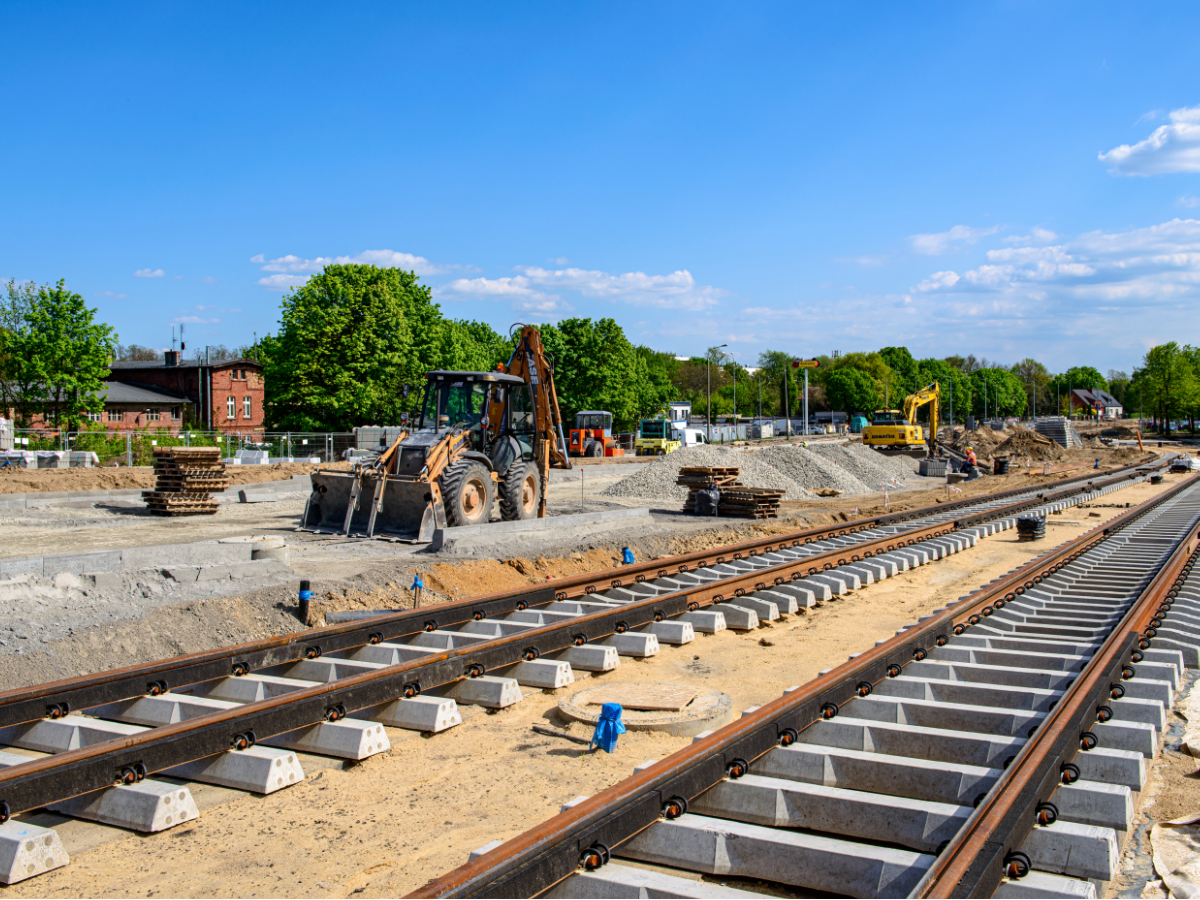– Technological advancement in recent years has allowed for a significant reduction in the propagation of vibrations to buildings. Residents will enjoy the fast and modern tramway route and the new road pavements that will not require renovation after a few years like before – says Prof. Tadeusz Tatara of the Cracow University of Technology.
Interview with Prof. Tadeusz Tatara*, Head of the Chair of Mechanics of Engineering Structures (Cracow University of Technology), who specializes in studying strains and vibrations in structures
The construction of a tram route in an area of intensive residential development – like the KST IV project – raises concerns about the impact of vibrations on nearby buildings. Is there a reason to be afraid of?
Prof. Tadeusz Tatara: – It is understandable that residents may have concerns regarding vibrations and its effects on the structures of buildings and the people inside them. The vicinity of a busy road is enough for the residents of nearby buildings to notice the impact, e.g. in the form of scratches or even cracks in the walls. This is usually safe for the structure itself yet is uncomfortable. Especially for someone who has recently painted the apartment.
Naturally, a lot depends on the technical condition of a building, but also on the quality of the transport infrastructure. Technological advancement in recent years has allowed for a significant reduction in the propagation of vibrations to buildings. An example might be the recently renovated Mogilska Street, where the existing buildings are located a short distance from the trackbed and the altered road network. The residents voiced their concerns about the project. And what is the status today? No complaints. A new, noise-reducing pavement is in place with properly selected vibration damping elements and a modern rolling stock used. The same goes for the KST IV project.
The residents of Mogilska Street are already used to a tramway route nearby. For those living along Młyńska or Dobrego Pasterza Streets it is a brand new experience…
– Tramway route is a comprehensive solution: trackbed, systems, rolling stock. Just compare the trams we had in Kraków 10-15 years ago and the ones on the tracks now. Also, various vibration damping solutions are mandatory these days. They always feature rail baseplates, polyurethane encapsulating compounds and vibration damping mats. I am currently supervising a research on a vibro-barrier, i.e. a partition in the ground installed to a certain depth which is using recycled materials. It is an additional element that can be used in this type of investments. If these solutions are appropriately selected and will meet standards regarding the impact of vibrations, then I would say that the negative impact of tramway traffic on buildings will be significantly limited
How do you select an appropriate damping solution?
– Already at the design stage an analysis is made that serves as the basis for a forecast on vibration impact and for selecting the appropriate vibration damping solutions. In the impact zone, representative buildings are selected and the so-called dynamic background is measured so that we establish the vibrations that occur in buildings at the quality of the communication system currently in place. These buildings must be carefully selected since we are looking for the weakest links – not buildings erected with the use of modern materials and technologies. Their number must be appropriate or the analysis will be imprecise and will trigger costs at the implementation stage related to the use of more expensive vibration damping mats along the entire route. In other words – savings at the analysis stage may be deceptive.
In the next step, models of representative buildings are calibrated and – using the database of vibration measurements at various tram runs – simulations are made. They take into account various aspects, e.g. ground conditions, gauge height. Adequate damping solutions are then selected to meet the standard conditions required.
It is difficult to talk about standards when we are faced with something versus which tolerance levels will vary. Someone may not feel the effects of the vibration while someone else will complain about it.
– Two aspects should be distinguished: the possible harmfulness of vibrations on the structure of buildings and the impact of the same vibrations on people inside the buildings. Naturally, each person may have a different threshold for perceiving such phenomena, but some things should be generalized. I have co-authored both the standard on the impact of vibrations transmitted by the ground on buildings and on the assessment of their impact by people. The standard for the assessment of the impact of vibrations on people distinguishes, among others, day and night time, buildings with various functions – hospitals, educational institutions, houses, etc. Such a generalization is possible, although it takes into account a number of variables.
And what about the standard for buildings? Do you take into account for instance their age?
– There are two scales. To put it simply: one refers to small buildings, the other to higher buildings: up to five storeys constructed using traditional method or with large-size elements. We have both these classes along the KST IV route: single-family houses at Krzesławicka Street and the ‘razor’ building at Meissnera Street.
Since a lot depends on the technical condition of a building, the time when it was erected – or rather the technology then used – also matters. For example, in the vicinity of the viaduct along Bora Komorowskiego Street we have 5-storey buildings from the turn of 1960s and 1970s made of large panels. What matters in this case is the quality of workmanship of the contacts between them. Every material is aging, so the contacts in such a structure are subject to degradation. If simulations and selections are made for these weakened buildings – in historic Krakow these are often centuries old – you can choose the appropriate vibration damping and prevent the effects of vibrations.
We are talking about forecasts. What if the vibrations bother the residents after the project is completed?
– After the ribbon-cutting ceremony and once the tram is operational and the drivers use the new pavement, you have to answer the question: is the vibration damping really effective? To this end, another measurement is recommended in the representative buildings. It is usually made 36-40 days after the project is completed. Results are then compared. If he levels are exceeded, further solutions must be sought.
It may turn out that the problem of cracks is not in the trackbed but in the building itself. That is why, prior to the project launch, the contractor makes an inventory of the technical condition of the buildings in the impact zone. Imagine a resident claiming for damages yet without justification – since the damage occurred before the project. Photo documentation is very helpful in such circumstances.
How can you minimize vibrations when trams are already running on the trackbed?
– The point where the wheel meets the rail is of key importance. Therefore, it is necessary to first of all reprofile wheels, grind the rails, lubricate them on the curves and take care of the appropriate quality of turnouts. The aim is to get rid of unevenness and the characteristic knocking of a passing tram. Drivers should be covering turnouts or curves with appropriate speed. Do not forget about the condition of trolleys, because if unbalanced, they also generate vibrations in the ground and are the cause of their propagation and impact on buildings.
Part of the KST IV tram route will run in a tunnel – how does that impact the intensity of feeling vibrations?
– It may sound unbelievable yet this works to the benefit of the residents. To put it simply, a reinforced concrete tram tunnel is a concrete box with a very large mass that is able to dampen some of the vibrations generated by trams. In the case of the tunnel section, the subsoil will be extremely important – its saturation is certainly checked as well as groundwater table in the area of Polsadu roundabout and Sudół Dominikański. This is because water is conducive to the transmission of vibrations.
The construction time will certainly be a difficult period for the residents. What can the contractor do to minimize the inconvenience of vibrations at this stage?
– Indeed, difficult times yet no one will remember the inconvenience once the construction works are over. Residents will enjoy the fast and modern tramway route and the new road pavements that will not require renovation after a few years like before. It is worth believing in technological progress and freeing yourself from thinking that life will be worse after the project.
Vibrations during the works will certainly be caused by numerous construction machines. A pile driving hammer will surely be a cause for complaints. As and when needed, sensors can be installed in the area of the works to monitor the vibration level on an ongoing basis and compare it with the standard parameters. You can then react and, for instance, change the settings of the dropweight.
Much depends on the contractor’s diligence when organizing the construction site. You can always improve the panel joints of the haulage road, but you can also make them correctly in the first place – to avoid the discomfort for the residents.
Interviewed by Gabriela Łazarczyk, Gülermak
*Prof. Tadeusz Tatara – specialist in the field of seismic and paraseismic vibrations, building dynamics, as well as diagnostics and monitoring of engineering structures. Author and co–author of over 220 publications, 4 trademarks, one patent application and 2 national standards to assess the impact of vibrations transmitted through the ground on buildings and people. The lead performer of 14 research projects financed from external sources.
For the KST IV Project. together with his team from the Cracow University of Technology, he will perform analyzes, taking into account in particular: determining the impact zones of dynamic vibrations on building structures and on people staying in buildings, the selection of representative buildings for analysis and the analysis of computer simulation results in the scope of calibrating calculation models and solutions minimizing dynamic impacts on building structures and on people indoors (if the computer simulation proves it necessary).



A tramwaje na tym odcinku będą mogły odjeżdżać z częstotliwością co 1,5 minuty. W okolicy ronda Polsadu pojawi się nowy wielopoziomowy węzeł przesiadkowy. Według przyjętych założeń, etap projektowania i pozyskiwania wszystkich niezbędnych zgód i pozwoleń potrwa do 2022 roku, a budowa będzie realizowana w latach 2022-2024.